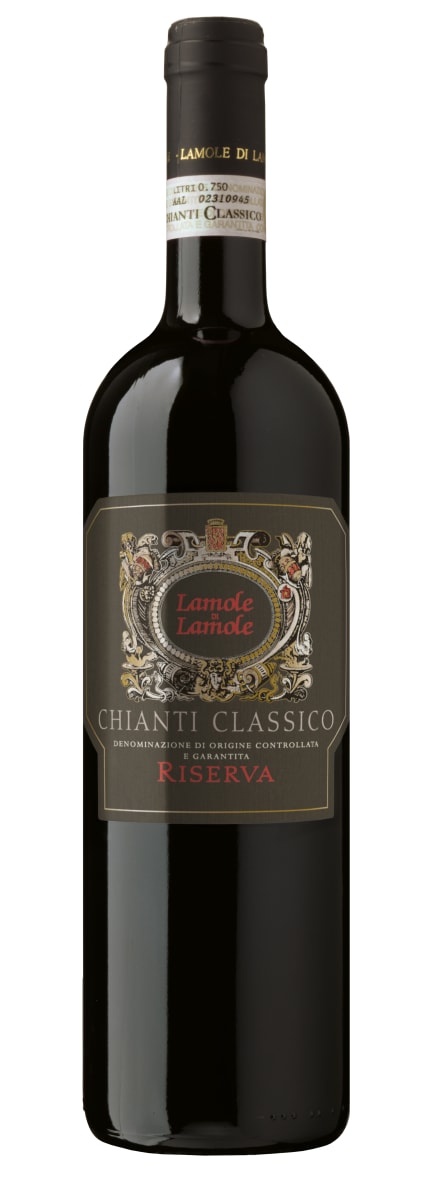Lamole di Lamole Chianti Classico Riserva 2014
-
James
Suckling



Product Details
Your Rating
Somm Note
Winemaker Notes
On the nose, the 2014 Riserva gradually unveils aromas of flowers, fruit, spice and gunflint in an intriguingly absorbing array of earthly wide-ranging aromatics. Sangiovese’s austere tannins are firmly in the traditional mold, underpinning progression on the subtly nuanced but very centered palate, which combines warmth, freshness, savoriness and minerality.
Sangiovese’s powerful structure makes this wine suitable for a wide variety of food pairings. highly flavored (non-fish) dishes are particularly recommended such as: grilled meats, salted pork, vegetables and cheeses.
Professional Ratings
-
James Suckling
Light aromas of strawberries, dark chocolate and cinnamon. Medium to full body, juicy tannins and a lively finish. Drink now.
Other Vintages
2017-
Wine
Spectator
-
Robert
Parker -
Wine
Enthusiast
-
James
Suckling
-
Wine
Enthusiast
-
James
Suckling
-
Wine
Spectator -
Wine
Enthusiast
-
Wine
Spectator





Lamole di Lamole draws its name and its character from the enchanting valley first discovered and cultivated by the Romans, and where these fine Chianti Classico wines were born. Selected from exclusive lines of grapes, shaped by the valley’s unique microclimate, and crafted in the cellars of an ancient castle, the wines of Lamole di Lamole offer exceptional flavors that complement the finest traditional meals and which only get better with age.
Since the 1800s, the Lamole valley has been renowned as one of the “cradles” of fine Chianti. Our winery is named after this valley and its history is just as revered. The historical Lamole di Lamole stone walls were rebuilt into the hillsides in the 1990s. These terraces, made from the local Macigno del Chianti rock, absorb and reflect the sun’s rays during the day and release heat during the night, so to provide the warmth that the vines need through the growing season.
The Lamole di Lamole vineyards in the hills of Chianti Classico are planted at some of the highest elevations of the region (1600 feet above sea level). The warm Tuscan sun and ventilation at these altitudes ensures even ripening and prevents dehydration in the grapes.
The estate grows the native Chianti grape varieties (sangiovese, canaiolo, malvasia nera and trebbiano toscano, the latter reserved for its Vinsanto) and several international ones, such as cabernet sauvignon, merlot, petit verdot and alicante.

Among Italy's elite red grape varieties, Sangiovese has the perfect intersection of bright red fruit and savory earthiness and is responsible for the best red wines of Tuscany. While it is best known as the chief component of Chianti, it is also the main grape in Vino Nobile di Montepulciano and reaches the height of its power and intensity in the complex, long-lived Brunello di Montalcino. Somm Secret—Sangiovese doubles under the alias, Nielluccio, on the French island of Corsica where it produces distinctly floral and refreshing reds and rosés.

One of the first wine regions anywhere to be officially recognized and delimited, Chianti Classico is today what was originally defined simply as Chianti. Already identified by the early 18th century as a superior zone, the official name of Chianti was proclaimed upon the area surrounding the townships of Castellina, Radda and Gaiole, just north of Siena, by Cosimo III, Grand Duke of Tuscany in an official decree in 1716.
However, by the 1930s the Italian government had appended this historic zone with additonal land in order to capitalize on the Chianti name. It wasn’t until 1996 that Chianti Classico became autonomous once again when the government granted a separate DOCG (Denominazione di Origine Controllata e Garantita) to its borders. Ever since, Chianti Classico considers itself no longer a subzone of Chianti.
Many Classicos are today made of 100% Sangiovese but can include up to 20% of other approved varieties grown within the Classico borders. The best Classicos will have a bright acidity, supple tannins and be full-bodied with plenty of ripe fruit (plums, black cherry, blackberry). Also common among the best Classicos are expressive notes of cedar, dried herbs, fennel, balsamic or tobacco.
